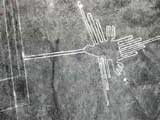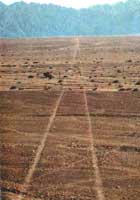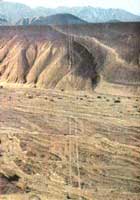|
Books by
Maria Reiche
“Markings: Aerial Views of Sacred Landscapes
by
Maria Reiche
Charles Gallenkamp
Keith Critchlow
Lucy Lippard
(Contributors)
Marilyn Bridges
(Photographer)
Haven O’More
(Preface)
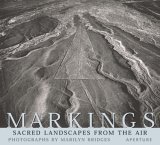
EU English Edition
“Mystery on the desert: A study of the ancient figures and strange delineated surfaces seen from the air near Nazca, Peru”
by
Maria Reiche
Unknown Binding
1949 Edition
“Geheimnis Der Wuste/
Mystery on the desert/
Secreto De La Pampa”
German/English/Spanish
by
Maria Reiche
Hardcover
1968 Edition
“Peruanische Erdzeichen/Peruvian Ground Drawings
German & English
by
Maria Reiche
(Author)
Malcolm G. Leybourne
(Translator)
Dr. Hermann Kern
(Translator)
Hermann Kern
(Foreword)
1974 1st Edition
“Geheimnis Der Wuste/
Mystery on the desert/
Secreto De La Pampa –
Preliminaries for a Scientific Interpretation of the Pre-Histori c Ground-Drawings of Nazca, Peru and Introduction to Their Study“
German/English/Spanish
by
Maria Reiche
Hardcover
1989 7th Edition
Signed by author
Books about the Nazca
lines & geoglyphs
“Maria And The Stars Of Nazca / Maria Y Las Estrellas De Nazca”
Spanish & English
by
Anita Jepson-Gilbert
Rodger Osban
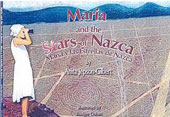
EU English Edition
“Ancient Nasca
Settlement & Society”
by
Helaine Silverman 
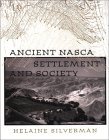
EU English Edition
“Nasca society arose on the south coast of Peru 2000 years ago and evolved over the course of the next 700 years. This text examines the range of sites occupied by the people responsible for some of the most exquisite art and ingenious hydraulic engineering of the pre-Columbian world.
“The Nasca
(Peoples of America)”
by
Helaine Silverman 
&
Donald A. Proulx 
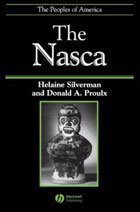
EU English Edition
“Ancient Nasca culture of the south coast of Peru is famous for its magnificent polychrome ceramics, textiles, and other works of art, as well as the enigmatic ground markings on the desert plain at Nasca. In the past two decades much has become known about the people who produced these fascinating works. This scholarly yet accessible book provides a penetrating examination of this important civilization.”
|
|
The aerial photographs below are of some of the more intricate drawings on the Nazca Plain. Taken from a height of several hundred feet, they clearly show the magnificent achievements of the ancient Nazcans in drawing each of the images using just one continuous line.
One theory is that these figures represented the constellations as seen in the Southern Hemisphere. Another theory, proposing that their outlines were in fact ceremonial pathways for single-file processions to honour the ‘sky gods’ of the ancient Nazcans, is an interesting explanation that deserves much greater consideration. Many of the lines are indeed thick enough to walk on, though this is obviously discouraged these days due to the extreme fragility of the lines, most of which are barely an inch or two deep.
Many of the lines are indeed thick enough to walk on, though this is obviously discouraged these days due to the extreme fragility of the lines, most of which are barely an inch or two deep.
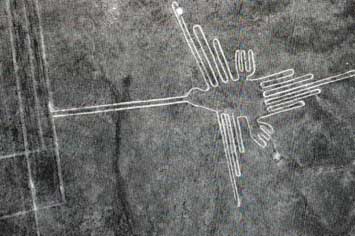
Copyright © 1949, Maria Reiche
This beautiful humming bird shows the destinctive style that the Nazca peoples used in all of these geoglyphs. You cannot mistake the animal, yet this artistic style has not been repeated on any of the pottery, or other artifacts, that has yet been discovered in the area near to the geoglyphs. Again the possibility of an astronomical explanation persists in the orientation of one of the parallel lines close to the geoglyph, and Maria Reiche says of this humming bird:
“The bill of this bird ends up at a group of lines, the last of which pointed to the rising sun on December 21st.”
The Winter Solstice of December 21st was celebrated by many cultures in antiquity, especially the druids of Britain and northwest Europe. Here at Nasca the geoglyphs are in the southern Hemisphere, so everything is reversed, and the rising sun on December 21st happens on the Summer Solstice for the peoples of Peru.
The geoglyph below is also thought to be that of a bird, though exactly which bird it is supposed to represent is still a mystery. Maria Reiche felt that the two small circles inside the outline might represent the eyes of the bird – eyes drawn with exact symmetry:
“The head of the largest bird is made of segments of circles, whose radii vary between 32 and 66 feet. The figure is much stylised, showing in profile, while two circles of equal diameter could represent two eyes. The two curves continuing from the end of the neck have exactly the same radius, both being concentrical to the eyes.”

Copyright © 1949, Maria Reiche
Seen from this height, and at this angle, it is reminicent of some of the ‘crop circle’ markings that appear in cereal fields each summer in many places around the globe. Though this figure, like the other geoglyphs in the area, is drawn on the surface of the desert pampa in an area which currently has one of the lowest annual rainfalls on the whole of the planet – and there is much evidence to suggest that this has been so for many centuries.
While humming bird geoglyph is obviously that – a humming bird – other bird figures are not that easy to indentify, as the bird’s head above clearly shows. The rest of the figure is made up of two parallel trapezoid-like shapes which obviously don’t belong to any known species of bird, but there are many others, and their importance in the overall ‘grand scheme’ at Nazca was recognised by Maria Reiche:
“It is evident that birds have been the principal topic of the imagery of ground-drawing art. Up to now eighteen birds have been found, their numbers only being surpassed by that of the ubiquitous spirals.”
In the image immediately below the foot of a giant bird is contrasted with both the human figure for scale, and the backdrop of the vista behind her, showing the complete setting with regard to the distant hills marking the local horizon for this, one of the largest of the geoglyphs on the Nazca plain.
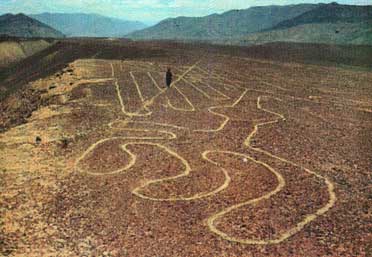
Copyright © 1949, Maria Reiche
“Occupying the foreground of the picture (above) is the foot of a huge bird, which was found beside many other drawings on a plateau above Palpa. Most figures are traversed by several straight lines, sometimes running parallel to part of the figure, or else, as is the case of the line shown here, coinciding with a short piece.
This arrangement seems to indicate, that figures were drawn specifically in places where several long, straight lines cross over each other. Figures and geometric patterns were preferably drawn at the very edge of the plateaux.”
The diagram below from Maria Reiche’s 1977 book, “Mystery on the Desert”, shows a number of geoglyphs in outline with a metric grid at the top and a grid in English feet at the bottom. Several of the bird figures are represented, and have been drawn to scale so that the varying sizes of the ground-drawings can be much better appreciated than they could in individual aerial photographs.
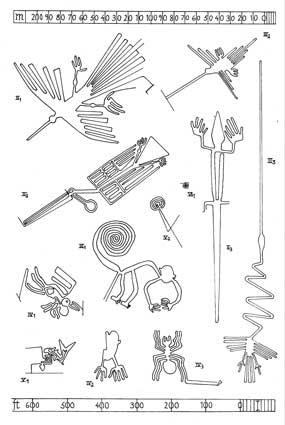
Copyright © 1949, Maria Reiche
As can be seen, some of the figures are many hundreds of feet long, while some of the other, smaller, figures could fit several times into the larger figures. Some appear to have been drawn unnaturally elongated, but the emphasis on certain features such as long legs, and ‘zig-zag necks’, simply illustrates the unique style of the Nazca drawings. And, contrary to common belief at the time Maria Reiche published her book in 1977, something of this style is indeed evident in many of the pottery shards since discovered on the Pampa.
In fact, it was the giant figure of a bird that was the first of the Nasca geoglyphs to be discovered, and there have been many bird-themed pottery fragments dicovered which are similar in style.
“When the largest drawings were frist seen from airplanes, they were taken to be remnants of ancient irrigation. No special attention was given them unitl Dr. Paul Kosok came to Peru to study ancient irrigation on the coast. After finding that they had nothing to do with it, he initiated the study of the figures with the discovery and re-tracing of a huge figure of a bird.”
all quotes on these tribute pages are from
“Mystery on the Desert”
by Maria Reiche
|
|
To understand why this News Page is sometimes late here is some information about Fibromyalgia
“Pathways to the Gods: The Mystery of the Andes Lines”
by
Tony Morrison
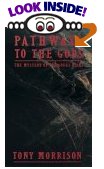
EU English Edition
“Nazca: Eighth Wonder of the World?”
by
Anthony F. Aveni
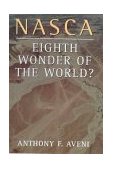
EU English Edition
“Between the Lines: The Mystery of the Giant Ground Drawings of Ancient Nasca”
by
Anthony F. Aveni
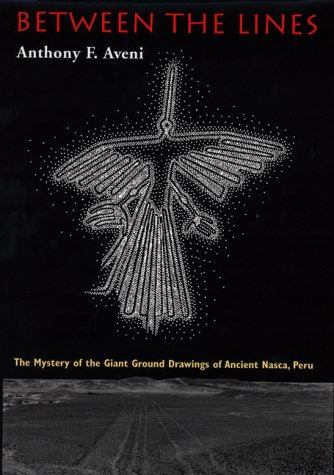
EU English Edition
“The Cities of the
Ancient Andes”
by
Andriana von Hagen
& Craig Morris

EU English Edition
“The largest empire of pre-Columbian America was toppled in under a decade by a handful of Spanish invaders who looted the fabled riches of its greatest city, Cuzco, and severed its 15,000 mile system of roads. But this Inca empire was only the final link in a chain of urban development stretching back to 2500 B.C. How did cities evolve in the ancient Andes?”
“The Nasca
(Peoples of America)”
by
Helaine Silverman 
&
Donald A. Proulx 

EU English Edition
“Ancient Nasca culture of the south coast of Peru is famous for its magnificent polychrome ceramics, textiles, and other works of art, as well as the enigmatic ground markings on the desert plain at Nasca. In the past two decades much has become known about the people who produced these fascinating works. This scholarly yet accessible book provides a penetrating examination of this important civilization.”
Nazca News
more information
about the Nazca lines
& geoglyphs on
:
Landscape Geometry
Lines Over Mountains
Animals & Landscape
Figures On The Plain
The Human Scale
Birds On The Pampa
The Spider Geoglyph
& The Stars Of Orion
Spirals In The Desert
if you would like to support our
astro-archaeology research projects
please send us a book

from our Wish List
|

